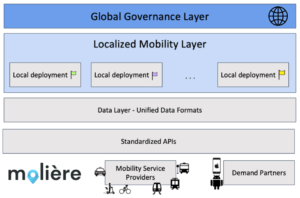Geolocation plays a key role in an exponentially-growing mobility ecosystem where traditional means of urban transportation are now being completed by the Mobility as a Service (MaaS) concept. So that a multimodal experience can be created and more options can be given to the public to freely move around cities, positioning technologies of vehicles and users’ smartphones are essential to plan and interoperate any mobility services. However, a situation is now faced where many mobility operators are collecting, processing and storing data independently, later sharing it if necessary but often via non-standard data formats and APIs.
Putting an end to this fragmentation of mobility services is the objective of Molière, for which the Mobility Data Marketplace (MDM) has been created. The main objective of Molière’s MDM is therefore to become an enabler platform of seamless, interoperable mobility by ingesting data from mobility services in a standardised format through the use of blockchain technology.
Within this context, a new paper has been prepared by Molière’s partners, Iomob and Factual, demonstrating the blockchain architecture behind the MDM, chosen as the preferred technology to enable a mobility ecosystem able to facilitate data publication, enrichment and rectification, its selective distribution, and the creation of protocols for data exchange and operations; thereby maximising the utility of the data and the mobility services that contributors provide. The key advantage that blockchain technology provides is that it enables the creation of a neutral, common-ground infrastructure that can be owned by either a consortium of organisations (private blockchains) or the public (public blockchains)– the commons blockchain being Molière’s preference based on the reasons explained thereafter.
Molière’s MDM aims to be a commons infrastructure that is governed by the stakeholders with an interest in its correct operation and maintaining its utility.
Based on the final goal of providing a commons infrastructure governed by mobility stakeholders, Molière’s MDM architecture is based on two separate blockchain layers, called the Governance and the Mobility layers: the former enabling stakeholders to make decisions about the infrastructure (incl. the Mobility layer), and the latter storing the actual mobility data and where the purchase of mobility services is facilitated.
Starting from the basics, the role of the Governance Layer is to act as the foundation of Molière’s MDM, being the enabler of transparency, openness and inclusiveness towards all mobility stakeholders. Consequently, the Governance Layer is to be implemented as a public Cosmos app chain in order to enable each and every transference of data or stakes between parties to be recorded in a publicly verifiable and auditable ledger. Additionally, the Cosmos app chain will need to be supported by the adoption of a token-based governance – where stake in the system is represented by a token held by specific stakeholders on a public blockchain, and which will enable token-weighted voting to make governance decisions. One of the particularities of the decision-making mechanism based on tokens is that this is based not on tokens owned, but on tokens staked on the network. This mechanism is designed as such to account mobility stakeholders responsible for the potential economic consequence of their decisions, this way also preventing particular secondary interests to come into play.

While the Governance Layer is in charge of making decisions about the maintenance and improvement of the MDM, the Mobility Layer is in charge of ingesting, processing, and offering access to data on mobility services, with the end goal of facilitating the discovery, combination, booking and payment of mobility services. The sensitivity of the mobility data is such, however, that the Mobility Layer is to be run on a private blockchain. This means that access to the data is carefully restricted on a need-to-know basis. For example, end-users can discover the mobility services and book them, but each end-user can only access their own bookings, while mobility companies can only access any user’s bookings of their own services.
In addition to GDPR-related matters, advantages of a private blockchain infrastructure are various: first, different operators can be approved for each geographical area (e.g. based on reputation and added value of fleet or activities). Additionally, node operators can cross-verify their work by introducing blockchain checks and balances that fully centralised systems do not feature (therefore making linked trips much easier for users). Finally, a private blockchain very naturally allows participants to be appointed or excluded dynamically by the Governance Layer, without the need to organise complex data transfers between organisations with the resources that implies.
Apart from the operational insights, a key feature of the Mobility Layer is that it features an API for third parties to push information about the mobility services they operate, including the availability and status of such services, and for end-users to discover such services, as well as book and pay for them. Interoperability is easily allowed by leaving the inclusion of API adaptors to MDM’s API specifications to operators, and not including specific restrictions for this. Additionally, the Mobility Layer also offers a journey planner that includes all the mobility services integrated in the MDM.
In summary, the main novelty of the MDM is that it runs on a decentralised architecture that combines a token-based governance mechanism on a public blockchain with territorially bounded deployments of its mobility layer, based on private blockchains. This combination of technologies allows the MDM to be effectively decentralised, while allowing for its customization for each region, usually but not only, due to regulatory issues.



